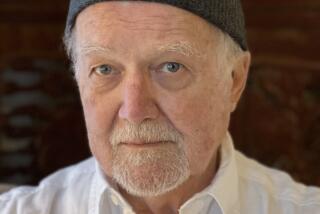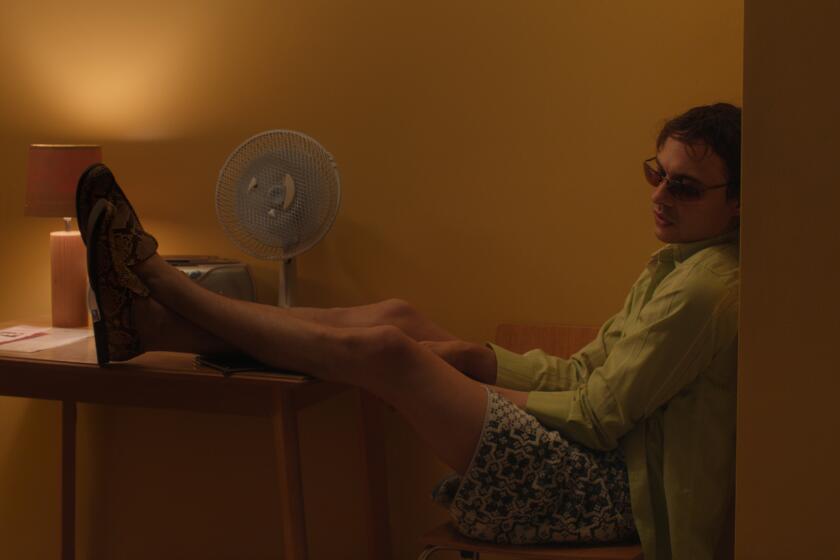A model of movie stardom
- Share via
He presented the first Academy Awards -- in his office. He founded what would become USC’s film school. He was the first to press his hands and feet into cement in front of Grauman’s Chinese Theatre, with his wife, who was America’s sweetheart. He co-founded a movie studio with Hollywood’s greatest director and two of its biggest stars.
If the name Douglas Fairbanks doesn’t ring a bell, that might be because he’s been dead for 70 years. Or maybe it’s because his greatest achievements were in silent films.
Either way, Jeffrey Vance’s biography “Douglas Fairbanks” retells the story of the man who became one of Hollywood’s first superstars.
Douglas Elton Ulman was born in Colorado in 1883. By the time he was 5, his father had abandoned the family and his mother reverted to Fairbanks, the name of her deceased first husband.
Fairbanks had tremendous energy and athleticism as well as a fondness for Shakespeare, and when a traveling theater troupe came through Denver, the 16-year-old persuaded the group to take him along. Eventually, his acting caught up with his enthusiasm; he had his first hit on Broadway in 1906.
That was the year he met Beth Sully; they married and after two years had a son, Douglas Fairbanks Jr. But Fairbanks was restless, and when a $2,000 a week offer came from Hollywood, he took it.
The camera loved his flashing smile, and his joyous physicality electrified the screen. He was so popular he even published a series of books (which were ghosted) lauding all-American optimism, athleticism and laughter.
His salary soon rose to $15,000 a week, making him one of Hollywood’s highest-paid stars. But this was just a fraction of the millions his movies made.
At actress Mary Pickford’s urging, he got out of his contract and started his own production company in 1917. Although many of his films from this period have been lost, Vance describes them and includes some stills; film scholars will appreciate his attention to significant crew members, although it feels a bit like sitting through a film’s credits.
In 1919, Fairbanks, Pickford and Charlie Chaplin joined director D.W. Griffith to launch United Artists. Metro Pictures’ president Richard Rowland skeptically remarked, “The lunatics have taken charge of the asylum.” Nevertheless, UA survived.
Meanwhile, Pickford and Fairbanks, still wed to other people, struck up an affair. Fans didn’t turn on them; when they married in 1920, they were embraced as luminous equals of beauty and fame. In Beverly Hills, their house, Pickfair, became a destination for both Hollywood’s elite and genuine royalty.
The year 1920 also saw the release of “The Mark of Zorro,” a landmark action-adventure picture. “Up until then,” Vance writes, “most costume films had been turgid affairs; Fairbanks contributed his winning charm, humor, and athleticism executed in a modern manner. His approach -- particularly his ingratiating humor -- gave his films great appeal to audiences of the 1920s and helped usher in a renaissance of costume adventures.”
Youth and vitality were essential to Fairbanks’ persona. His physique was so perfect that he was, artist Joe Schuster explained, the model for his comic book character Superman.
But Fairbanks was more than just a graceful athlete. Using contemporary accounts and first-person histories, Vance makes the case for him as an early auteur.
He was involved in every stage of production, selecting properties, working so closely with his writers that he got credit (as “Elton Thomas”), bringing on researchers for historical accuracy, reviewing casting and production design and original scores.
He created a wall-size blueprint system for his shooting schedules and often served as de facto director. Like Hitchcock, he tackled technological challenges, building massive sets for one film, using miniatures and glass shots in another, even shooting “The Black Pirate” (1926) in two-color Technicolor.
When “The Black Pirate” was released, Fairbanks was in top form; a snapshot shows him bronzed and muscled on the beach. But he was 43, a rival studio had recruited his son to capitalize on his name and he’d been playing a youth for more than a decade.
Emphasizing the professional over the personal, Vance focuses on Fairbanks’ career. “Douglas Fairbanks as The Gaucho” (1927) showed a shift in his persona: for the first time, he drank and smoked on-screen. He danced a steamy tango with Lupe Velez, with whom he had an affair. (Adding insult to injury, he cast Pickford in a cameo as the Virgin Mary.)
While audiences thrilled to “The Jazz Singer” in 1927, sound was the one technological advance Fairbanks wouldn’t embrace. Instead, he looked backward, reprising one of his most popular characters, D’Artagnan, in 1929’s “The Iron Mask.” Vance sees this film, Fairbanks’ last silent picture, as a farewell: In it, all the musketeers die.
Of course, to read about Fairbanks, even looking at his stunning photos, is not enough to understand his work. He crafted his own pantomime code, in which he never just pointed but lunged, one arm extended, head thrown back, eyes flashing.
The artistry of it takes some getting used to -- these vibrant, nakedly joyous displays of action.
But when he hurls his arms open, embracing the millions on our side of the screen, it is impossible not to want to hug him back.
More to Read
Only good movies
Get the Indie Focus newsletter, Mark Olsen's weekly guide to the world of cinema.
You may occasionally receive promotional content from the Los Angeles Times.









